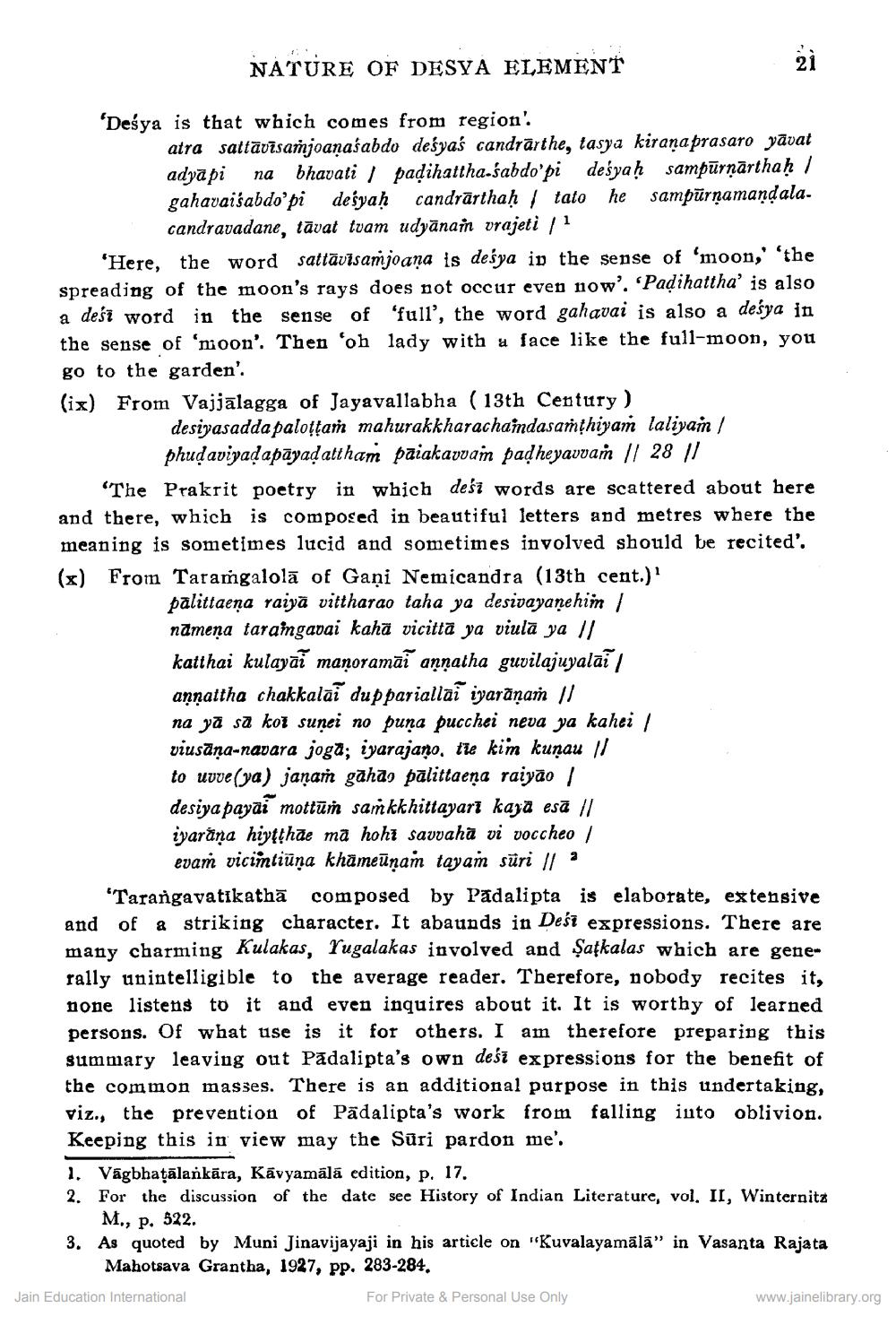________________
NATURE OF DESYA ELEMENT
'Deśya is that which comes from region'
atra sattāvīsajoanaśabdo desyaś candrarthe, tasya kirana prasaro yāvat adyapi na bhavati / padihattha-sabdo'pi desyaḥ sampūrņārthaḥ / gahavaisabdo'pi desyah candrārthaḥ / tato he sampurnamandala.
candravadane, tāvat tvam udyānain vrajeti / 1 'Here, the word sattävisamjoana is desya in the sense of 'moon,' 'the spreading of the moon's rays does not occur even now'. 'Padihattha' is also a desi word in the sense of 'full', the word gahavai is also a deśya in the sense of 'moon'. Then 'oh lady with a face like the full-moon, you go to the garden'. (ix) From Vajjalagga of Jayavallabha ( 13th Century )
desiyasadda palottam mahurakkharachamdasamthiyam laliyan /
phudaviyadapāyad attham paiakavvam pad heyavvam // 28 // "The Prakrit poetry in which deść words are scattered about here and there, which is composed in beautiful letters and metres where the meaning is sometimes lucid and sometimes involved should be recited'. (x) From Taramgalolā of Gani Nemicandra (13th cent.)'
palittaena raiyā vittharao taha ya desivayanehinn / namena taramgavai kahā vicitta ya viulā ya 11 katthai kulayāī manoramāí annatha guvilajuyalai | annattha chakkalās duppariallaí iyarāṇam 11 na ya sa kot sunei no puna pucchei neva ya kahei / viusāna-navara joga; iyarajano, tre kim kunau 1/ to uvue(ya) janaṁ gahda pālittaena raiyão / desiya payai mottūí samkkhittayari kaya esā // iyarána hiytthae ma hohi savvahā vi voccheo / evaṁ vicimtiūna khämeūnam tayan süri //
"Tarangavatikathā composed by Padalipta is elaborate, extensive and of a striking character. It abaunds in Desi expressions. There are many charming Kulakas, Yugalakas involved and șatkalas which are generally unintelligible to the average reader. Therefore, nobody recites it, none listens to it and even inquires about it. It is worthy of learned persons. Of what use is it for others. I am therefore preparing this summary leaving out Padalipta's own desī expressions for the benefit of the common masses. There is an additional purpose in this undertaking, viz., the prevention of Pädalipta's work from falling into oblivion. Keeping this in view may the Sūri pardon me'. 1. Vägbhatālankāra, Kāvyamālā edition, p. 17. 2. For the discussion of the date see History of Indian Literature, vol. II, Winternitz
M., p. 522. 3. As quoted by Muni Jinavijayaji in his article on "Kuvalayamālā" in Vasanta Rajata
Mahotsava Grantha, 1927, pp. 283-284. Jain Education International For Private & Personal Use Only
www.jainelibrary.org




